What Is The NER Registration Process? Step-by-Step Full Guide
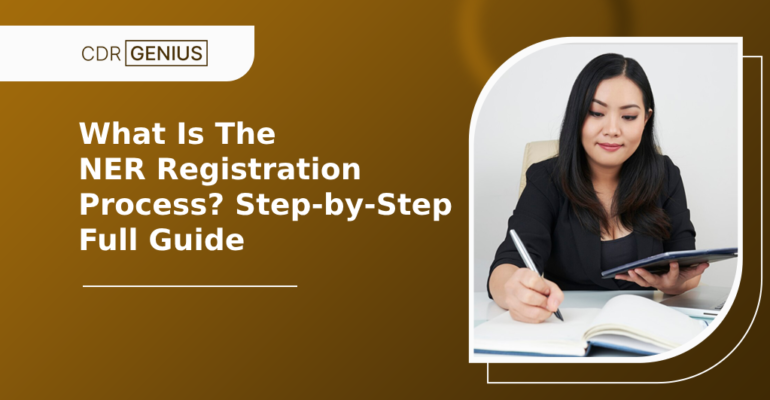
What Is The NER Registration Process? Step-by-Step Full Guide
Australia offers skilled engineers various opportunities, and registering on the National Engineering Register (NER) is an essential step towards professional recognition and enhancing your career prospects.
The Engineers Australia NER register confirms your competency, credibility, and commitment to the profession. This comprehensive guide outlines the entire NER registration process step by step.
🔑 Key Highlight
-
-
- Professional Recognition and Career Boost: Engineering professionals who join the National Engineering Register at Engineers Australia prove their capabilities alongside their integrity in design standards while demonstrating commitment to professional advancement, leading to better credibility and increased job prospects, especially for skilled migrants.
- Pathway to Skilled Migration and Licensing: Being on the NER improves your status as a skilled migrant candidate while providing support for visa applications and constituting a requirement for Australian professional licensing and Chartered Engineer status.
- Exclusive Benefits for Registered Engineers: Signing up as an NER member provides public accessible profiles and professional networking capabilities as compliance requirements for continuing professional development programs and enables acceptance into senior roles with higher compensation in Australia’s engineering profession.
-
What is the National Engineering Register (NER)?
The National Engineering Register (NER) is a comprehensive database managed by Engineers Australia (EA). It provides formal recognition for qualified engineers in Australia, helping them demonstrate their professional capabilities and enhancing their employment opportunities.
Being on the NER register is highly beneficial for skilled immigrant engineers looking to establish themselves in Australia’s engineering industry.
Why Is NER Registration Important for Skilled Immigrants?
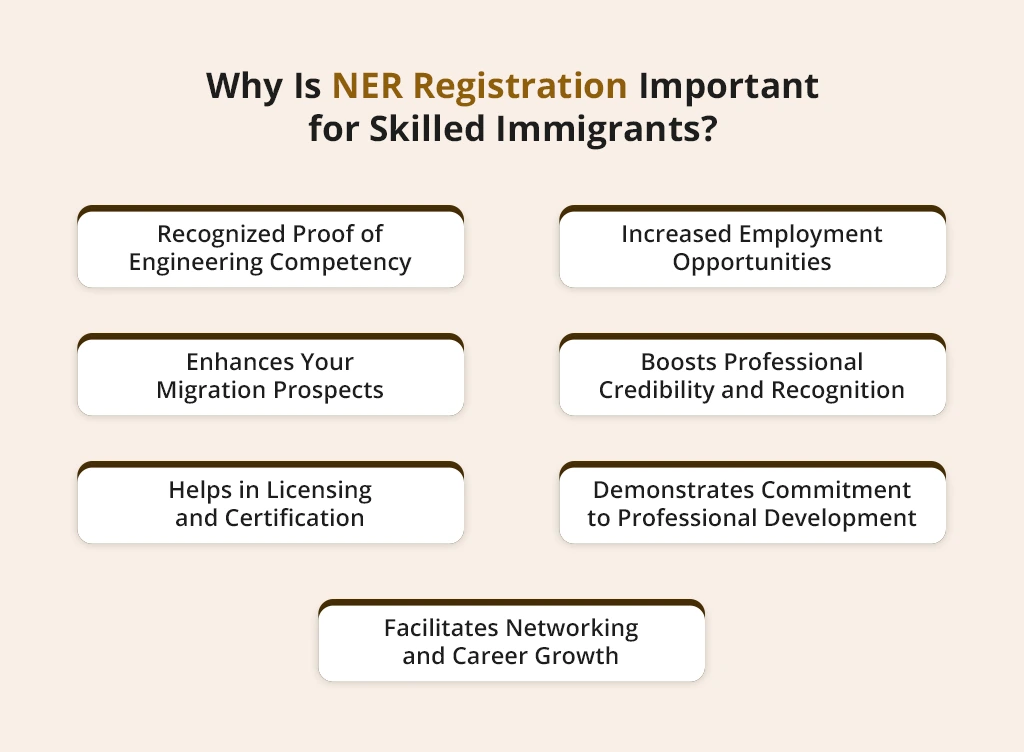
For skilled immigrants aiming to establish a professional engineering career in Australia, National Engineering Register (NER) registration is a crucial step. Here’s why:
1. Recognized Proof of Engineering Competency
NER registration serves as a formal recognition of your skills, experience, and professionalism in engineering. It assures employers, clients, and regulatory bodies that you meet Australian engineering standards.
2. Increased Employment Opportunities
Many Australian employers prioritise NER-registered engineers when hiring, as it demonstrates industry-recognised competency. Some government projects and engineering firms even require NER registration as a mandatory qualification.
3. Enhances Your Migration Prospects
- If you are applying for a skilled migration visa, being NER-registered can strengthen your profile and increase your chances of securing sponsorship or permanent residency.
- It aligns with Engineers Australia’s competency standards, which play a key role in the Migration Skills Assessment (MSA) process.
4. Boosts Professional Credibility and Recognition
- Being listed on the NER database establishes your credibility as a qualified engineer in Australia.
- It provides public visibility, allowing potential employers and clients to verify your credentials easily.
5. Helps in Licensing and Certification
- Some states and territories in Australia require NER registration for professional licencing.
- It is an essential step for engineers seeking chartered status or roles that require independent certification.
6. Demonstrates Commitment to Professional Development
- NER registration requires compliance with Continuing Professional Development (CPD) standards.
- This commitment to ongoing learning and skill enhancement makes you a competitive candidate in the job market.
7. Facilitates Networking and Career Growth
- As a registered engineer, you gain access to professional engineering networks and industry events.
- This opens doors to mentorship, collaborations, and career advancement opportunities.
Step-by-Step Guide to the NER Registration Process
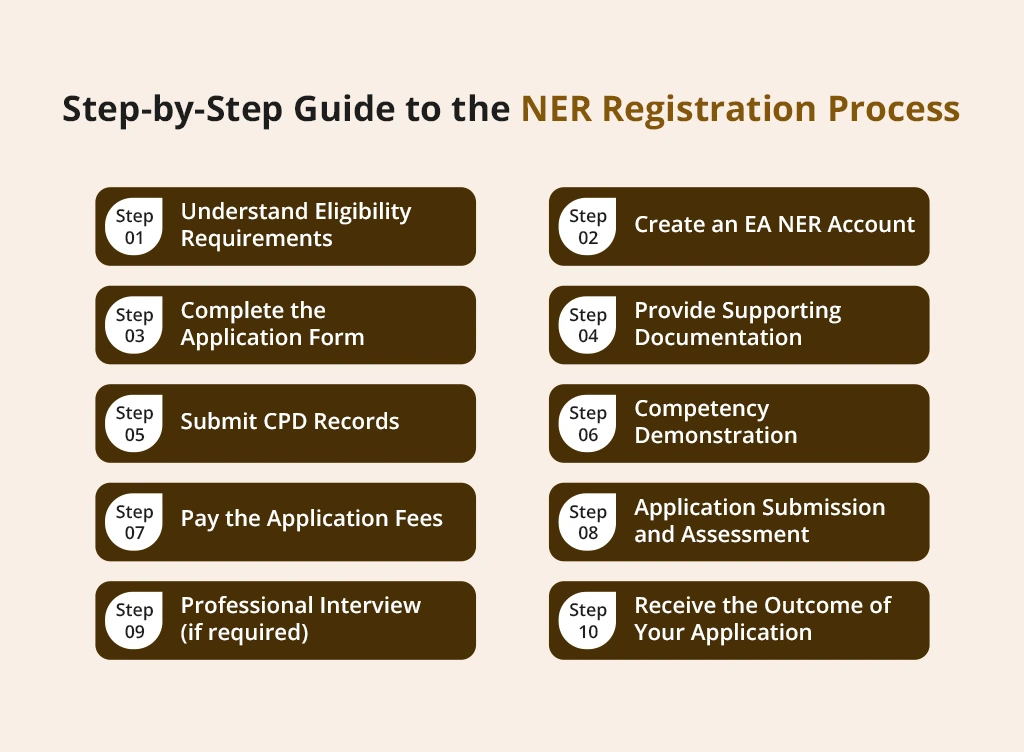
Step 1: Understand Eligibility Requirements
Before starting your NER application, ensure you meet the eligibility criteria set by Engineers Australia:
- Hold an accredited engineering qualification.
- Relevant professional experience (typically 5 years or more).
- Commitment to continuing professional development (CPD).
Step 2: Create an EA NER Account
To begin your application:
- Visit the Engineers Australia website.
- Register or log in to your EA account.
- Navigate to the “National Engineering Register” section.
(Image placeholder—screenshot of EA NER registration page)
Step 3: Complete the Application Form
The NER application form requires detailed personal and professional information, including:
- Personal details (passport, visa, and contact information).
- Educational qualifications.
- Employment history.
- Areas of engineering expertise.
Make sure the information provided is accurate to avoid delays.
Step 4: Provide Supporting Documentation
Your application must include:
- Certified copies of your academic qualifications.
- A current CV clearly outlining your engineering experience.
- Proof of continuing professional development (CPD).
- Professional references from credible sources.
(Image placeholder—documents required for NER)
Step 5: Submit CPD Records
Engineers Australia mandates at least 150 hours of CPD within the last three years. Ensure your CPD records:
- Reflect relevant engineering activities.
- Include detailed descriptions of activities and learning outcomes.
- They are organised and easy to review.
Step 6: Competency Demonstration
You must demonstrate competencies as outlined by Engineers Australia, including:
- Engineering knowledge and skill application.
- Professionalism and ethical conduct.
- Effective communication and teamwork skills.
(Image placeholder—competency standards overview)
Step 7: Pay the Application Fees
Application fees vary depending on your EA membership status. Confirm the exact fees applicable to your situation on the EA website. Payments can be made via credit card or bank transfer.
Step 8: Application Submission and Assessment
After submitting your application:
- EA will review your provided documentation.
- They might request additional information if necessary.
- Assessment typically takes 4-6 weeks.
Step 9: Professional Interview (if required)
In some cases, Engineers Australia may conduct a professional interview. Prepare by:
- Reviewing your submitted documentation thoroughly.
- Clearly articulating your engineering skills and experiences.
(Image placeholder—preparing for the EA professional interview)
Step 10: Receive the Outcome of Your Application
Once assessed:
- Successful applicants receive confirmation and are added to the NER register.
- If unsuccessful, EA provides detailed feedback, allowing for reassessment after addressing highlighted issues.
Benefits of Being on the NER Register
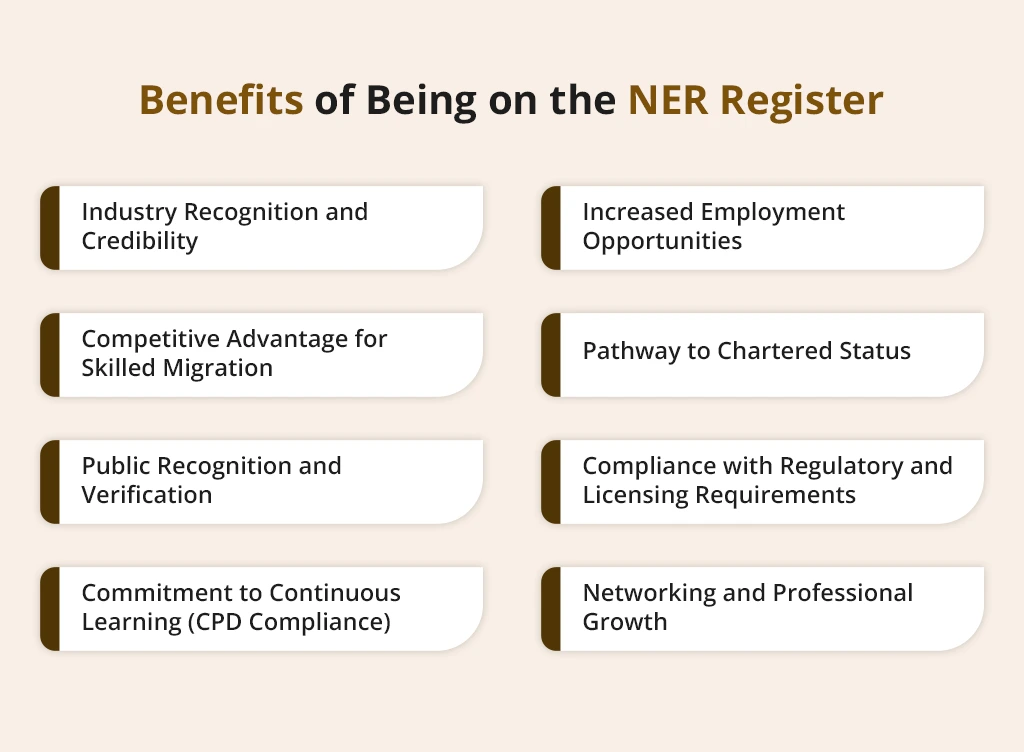
Being listed on the National Engineering Register (NER) offers numerous advantages for engineers in Australia. Whether you’re a local professional or a skilled immigrant, NER registration enhances your career prospects, credibility, and professional growth. Here are the key benefits:
1. Industry Recognition and Credibility
- The NER is a nationally recognised register managed by Engineers Australia.
- Being listed demonstrates that you meet high professional and ethical standards, making you more trustworthy to employers, clients, and industry regulators.
2. Increased Employment Opportunities
- Many government projects, large corporations, and private firms prefer or require engineers to be NER-registered.
- Registration sets you apart from non-registered engineers, improving your chances of securing higher-paying roles and leadership positions.
3. Competitive Advantage for Skilled Migration
- For skilled immigrants, NER registration can strengthen your profile in visa applications.
- It aligns with Engineers Australia’s Migration Skills Assessment (MSA) process, making it easier to gain employer sponsorship or PR pathways.
4. Pathway to Chartered Status
- Being on the NER register is often a stepping stone towards becoming a Chartered Professional Engineer (CPEng).
- Chartered status further enhances your career progression and opens doors to senior engineering roles.
5. Public Recognition and Verification
- Your name is listed in a searchable public database, allowing potential employers and clients to verify your credentials quickly.
- This increases your professional visibility, helping you attract new job opportunities or engineering contracts.
6. Compliance with Regulatory and Licensing Requirements
- Some state engineering boards and professional licensing bodies recognise NER registration as part of their licensing requirements.
- It may be required for engineering sign-off authority in various sectors, including construction and infrastructure.
7. Commitment to Continuous Learning (CPD Compliance)
- NER-registered engineers must engage in Continuing Professional Development (CPD), ensuring they stay updated with industry advancements.
- This helps in career growth and keeps you competitive in the ever-evolving engineering landscape.
8. Networking and Professional Growth
- Being NER-registered connects you to a network of recognized engineering professionals.
- You gain access to exclusive industry events, training programs, and mentorship opportunities, helping you expand your professional reach.
Tips for a Successful NER Application
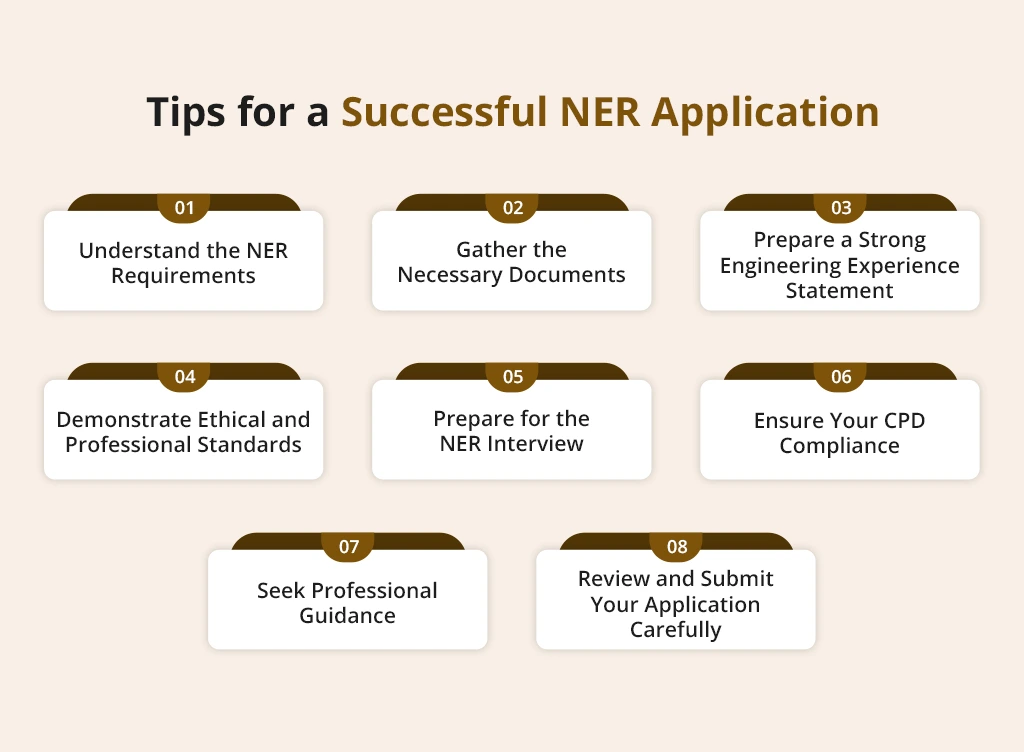
Applying for the National Engineering Register (NER) requires careful preparation to ensure a smooth process. Follow these essential tips to strengthen your application and improve your chances of success:
1. Understand the NER Requirements
- Ensure you meet the eligibility criteria, including at least five years of relevant engineering experience.
- Be familiar with the NER competencies, such as technical proficiency, ethical practice, and communication skills.
2. Gather the Necessary Documents
- Updated CV: Clearly outline your engineering experience and responsibilities.
- Engineering Qualifications: Ensure you have certified copies of your degree or equivalent qualifications.
- Continuing Professional Development (CPD) Records: Maintain a detailed log of training, courses, and professional learning activities.
3. Prepare a Strong Engineering Experience Statement
- Highlight key projects that demonstrate your technical expertise.
- Focus on problem-solving skills and professional decision-making in real-world engineering challenges.
- Use clear and concise language with measurable outcomes.
4. Demonstrate Ethical and Professional Standards
- Engineers Australia places high importance on ethical practice and professional conduct.
- Be ready to explain how you adhere to industry standards and engineering ethics in your work.
5. Prepare for the NER Interview
- The NER interview is a crucial step in the assessment process.
- Expect questions about your engineering competencies, project experience, and ethical decision-making.
- Practice articulating your responses clearly and confidently.
6. Ensure Your CPD Compliance
- Engineers Australia requires engineers to engage in Continuing Professional Development (CPD) to stay updated with industry advancements.
- Maintained accurate records of training sessions, workshops, and technical seminars.
7. Seek Professional Guidance
- If you’re unsure about your application, consider consulting a professional using NER application assistance services.
8. Review and Submit Your Application Carefully
- Double-check all documents for accuracy and completeness before submission.
- Ensure all information aligns with Engineers Australia’s guidelines to avoid unnecessary delays.
By following these tips, you can enhance your NER application and increase your chances of securing a place on the National Engineering Register (NER) in Australia. 🚀
Conclusion
Registering on the National Engineering Register (NER) significantly improves your professional standing and career opportunities in Australia. By following this comprehensive step-by-step guide, skilled immigrant engineers can successfully navigate the NER registration process, enhancing their chances of a prosperous career in the Australian engineering industry.
Being on the National Engineering Register (NER) not only boosts your credibility and employability but also provides a pathway to chartered status, professional networking opportunities, and compliance with industry standards
Whether you’re a local engineer or a skilled immigrant, obtaining NER registration can significantly strengthen your career growth in Australia.
If you’re ready to advance your engineering career, start your NER registration journey today and take advantage of the numerous benefits that come with being a recognized professional in the Australian engineering industry! 🚀
FAQs
1. How long does the NER registration take?
Typically, 4-6 weeks, though it can vary based on individual cases.
2. What is the NER Interview for Engineers Australia?
The NER interview serves as the final stage of your assessment process. It can be conducted online via video conferencing or in person at Engineers Australia offices. During the interview, your engineering experience, projects, and competencies will be thoroughly examined.
3. Is EA membership mandatory for NER registration?
Membership isn’t compulsory, but EA members receive discounted registration fees.
4. Can I apply for multiple engineering areas in the NER?
Yes, you can demonstrate competence in each area through documentation and experience.
5. How to Become a Registered Professional Engineer in Australia?
To qualify for registration, you must hold a four-year full-time bachelor’s degree or a Master of Engineering from an accredited Australian institution. If you lack this qualification, alternative pathways include an equivalent part-time degree or a historically recognized equivalent qualification.
6. What is the NER Qualification?
The National Engineering Register (NER) is a publicly accessible database that lists engineers who have demonstrated a high level of professionalism and competency in their respective fields for at least five years.
 Chat with us
Chat with us